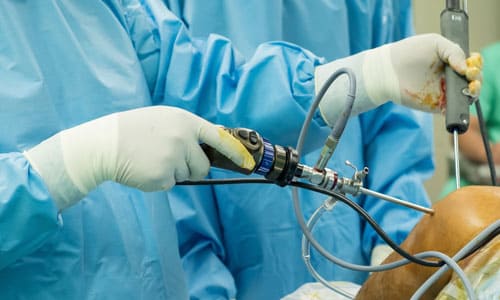
Arthroscopic Surgery is performed through small incisions using a camera to visualize the inside of a joint. Through several small incisions (about 1 centimeter each) your surgeon will insert a camera into one incision, and small instruments through the other incisions.
Shoulder Arthroscopy Is arthroscopic surgery better than traditional “open” surgery?
It depends. Open surgery, a procedure using larger incisions and enabling the surgeon to look inside the joint, may be better for certain procedures under certain circumstances. Arthroscopic surgery has some advantages–smaller incisions, less tissue damage–but these are usually not helpful if the overall procedure cannot be performed as well. You need to discuss with your surgeon if a particular procedure can be done arthroscopically.
I received two different opinions about surgery and only one said arthroscopic was better–who is right?
Well, there is no clear answer. There are debates among orthopedic surgeons about how to best perform different types of surgery. For example, many shoulder surgeons disagree about whether or not rotator cuff repairs can be performed as well arthroscopically as they can open. Unfortunately, there are pros and cons to both, and no one knows for sure that one or the other is better.
What conditions can be treated with arthroscopic shoulder surgery?
1.Rotator Cuff Tears
Treatment of rotator cuff tears with shoulder arthroscopy is controversial. Some orthopedic surgeons treat all rotator cuff tears arthroscopically, some choose particular tears, and others treat them all open. There is no consensus which one is better. For more information about the controversy, you can read the following article:Arthroscopic treatment of rotator cuff tears
2. Shoulder Instability – Labral Tears – Slap Lesions
Labral tears, such as Bankart lesions and SLAP tears, are commonly treated with arthroscopy. It is very important that patients who have arthroscopic surgery for these procedures follow their post-operative rehab protocol very closely. Patients are often tempted to do too much too soon!
3. Impingement Syndrome
Patients with impingement syndrome that is not cured with conservative treatments may consider a procedure called an arthroscopic subacromial decompression. This procedure removes the inflamed bursa and some bone from the irritated area around the rotator cuff tendons. By removing this tissue, more space is created for the tendons and the inflammation often subsides.
4. Biceps Tendonitis
The biceps tendon can become irritated and inflamed as an isolated problem or in association with problems such as impingement syndrome and rotator cuff tears. When the biceps tendon is damaged and causing pain, a procedure called a biceps tenodesis can be performed. This procedure usually causes no functional difference, but often relieves symptoms.
5. Frozen Shoulder
Frozen shoulder seldom requires operative treatment, and treatment for many months or years is often necessary before considering operative treatment. When frozen shoulder must be treated surgically, it is of utmost importance to begin aggressive physical therapy immediately following surgery. Without this, it is likely the problem will return.
6. AC Joint Arthritis
The AC joint, or acromioclavicular joint, is occasionally affected by arthritis. When arthritis of the AC joint is severe, the end of the clavicle (collarbone) can be removed. By removing the damaged joint, the symptoms of AC arthritis are often relieved.
What is the recovery from shoulder arthroscopy?
The recovery depends on what type of surgery is performed. One of the problems with shoulder arthroscopy is that the procedure hurts much less than open shoulder surgery, and therefore patients may tend to do too much, too soon. It is very important that you only perform activities that your surgeon recommends following a shoulder arthroscopy. Even though your shoulder may feel fine, you need to allow time for repaired tissues to adequately heal. This is especially important for patients who have rotator cuff repairs and labral repairs.
- Fracture Around The Shoulder
- Shoulder Arthroscopy
- Shoulder Impingement
- Rotator Cuff Tear
- frozen Shoulder
- Shoulder dislocation
- Shoulder Joint Replacement
- Biceps Tendinitis
- Reverse Shoulder Replacement Surgery
- Calcific Tendinitis
- Elbow Replacement
- Elbow Arthroscopy
- Tennis Elbow
- Wrist Fractures
- Wrist Scaphoid Fractures
- Wrist Arthroscopy
- Rheumatoid Wrist
- Carpal Injuries
- Wrist Scaphoid Nonunion
